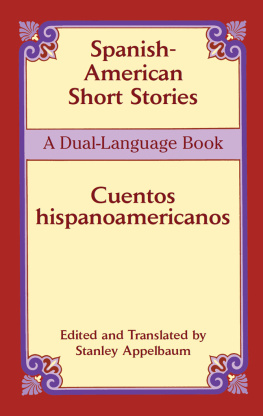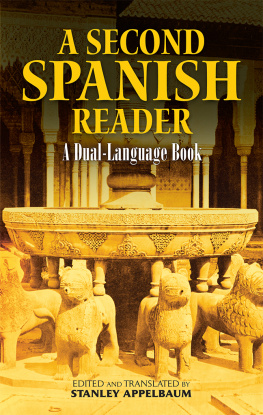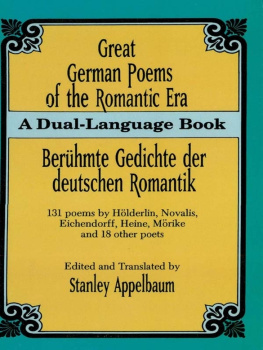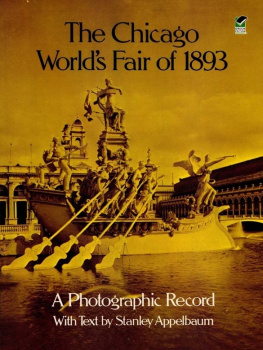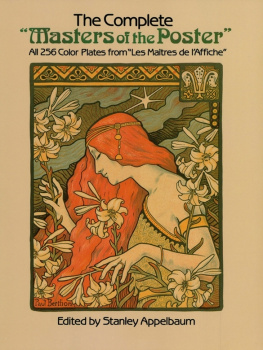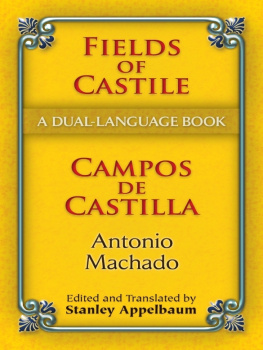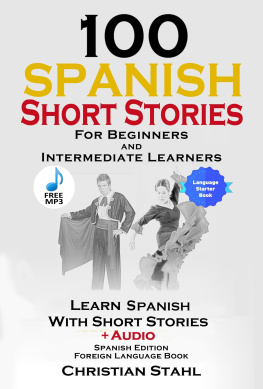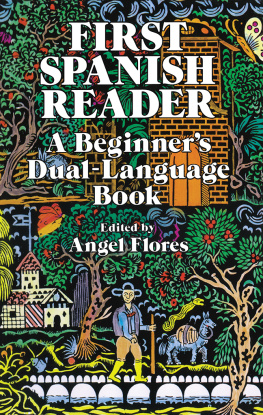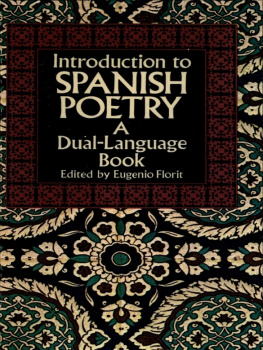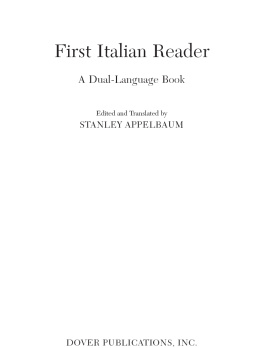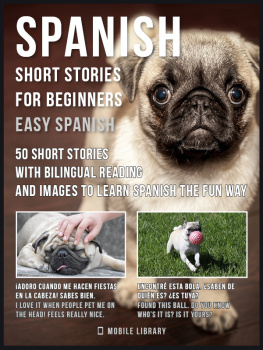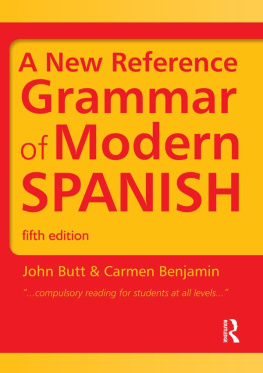Spanish- American Short Stories
Cuentos hispanoamericanos
Spanish- American Short Stories
Cuentos hispanoamericanos
A Dual-Language Book
Edited and Translated by
STANLEY APPELBAUM
DOVER PUBLICATIONS, INC.
Mineola, New York
Copyright
Selection, English translations, Introduction, and footnotes copyright 2005 by Dover Publications, Inc.
All rights reserved.
Bibliographical Note
This Dover edition, first published in 2005, is a new anthology of seventeen Spanish-language short stories (reprinted from standard texts), by seventeen different authors and from seventeen different New World countries, that were originally published between 1867 and 1922. (See Introduction for individual first-publication data.) The stories are accompanied by new English translations by Stanley Appelbaum, who made the selection and wrote the Introduction and footnotes.
Library of Congress Cataloging-in-Publication Data
Spanish-American short stories = Cuentos hispanoamericanos / edited and translated by Stanley Appelbaum.
p. cm. (Dual-language book)
eISBN 13: 978-0-486-12045-4
1. Short stories, Spanish AmericanTranslations into English. 2. Spanish American fiction20th centuryTranslations into English. 3. Short stories, Spanish American. 4. Spanish American fiction20th century. I. Title: Cuentos hispanoamericanos. II. Appelbaum, Stanley. III. Series.
PQ7087.E5S65 2005
863'.010898'0904dc22
2005042029
Manufactured in the United States of America
Dover Publications, Inc., 31 East 2nd Street, Mineola, N.Y. 11501
CONTENTS
[The data in square brackets are the year of first publication and the country of the authors birth.]
[1867; Ecuador]
[1888; Nicaragua]
[1889; Per]
[1889; Cuba]
[1903; Panam]
[1904; Chile]
[1904; Honduras]
[1905; El Salvador]
[ 1906; Bolivia]
[1906; Argentina]
[1908; Repblica Dominicana]
[1912; Uruguay]
[1914; Paraguay]
[1914; Colombia]
[1915; Guatemala]
[1917; Mxico]
[1922; Venezuela]
INTRODUCTION
The gratifying international recognition accorded to Spanish-American fiction writers of the last few decades is one of the most noteworthy phenomena in recent literary history. Yet, richly as late 20th-century authors deserve their fame and awards, their achievement would not have been possible without the foundations laid by talented predecessors. From the crucial formative period of Spanish-American creative prose, ending circa 1920, this Dover volume offers a tasting menu of 17 stories by 17 authors born in 17 different nations. The stories, differing widely in length, themes, and style, have all been deemed worthy of publication in earlier Spanish-language anthologies (some repeatedly), and each of the authors is a major (sometimes the outstanding) figure in his own countrys literary annals, a few enjoying truly worldwide repute. The sequence is chronological, by year of first publication of the stories.
Novels and short stories were generally frowned upon, and the writing of them discouraged, during the colonial period. The novel made a tentative appearance during the struggle for independence, with the Mexican Jos Joaqun Fernndez de Lizardis El periquillo sarniento (The Itching Parrot) in 1816, and a fair number of good novels appeared in various countries from the 1840s on. But the short story had a harder road to travel in the 19th century, and was scarcely in evidence in the Romantic era; a few stories published by the great Cuban poet Jos Mara Heredia in the years around 1830 may not after all have been originals; and the indubitable masterpiece El matadero (The Slaughterhouse), a hardhitting political allegory by Esteban Echeverra of Argentina, though written circa 1838, was not published until 1871, twenty years after his death. It was only in the following periods (Realism, Naturalism) that stories began to appear with any regularity, and even then the genre was not always pure, but mingled with essayistic, historiographic, and other features; influ ences derived from various European countries, chiefly Spain and France.
The short story came into its own when Spanish-American literature as a whole did: in the era of modernismo (roughly 18801920). This movement, truly New World in character, was an art-for-arts-sake revolt by young Spanish-American poets and prose writers against monotony and the perceived trammels of Realism, with its strong ties to the bourgeoisie that they despised. The modernistas were particularly inspired by the various literary currents emanating from France in the last third of the 1800s: the Parnassians, with their haughty reserve, classically chiseled language, and exotic subject matter; the Symbolists, with their metaphysical depth and incantatory style; the Decadents, with their recherch diction and worship of luxury. Bohemianism, fantasy, verbal experimentation, and self-exaltation were some of the hallmarks of the modernistas. (Of course, in every literary era, not every writer subscribes to the prevalent trends, and the stories of this period also offer many other aspects.) The period covered in this volume also includes the beginnings of the next major Spanish-American trend, criollismo, a partial return to realism with a heightened awareness of local conditions.
Because the editor wished to allot as many as possible of the pages at his disposal to the stories themselves, the sections of this Introduction devoted to the individual authors are all too brief, though they include first-publication data that are more complete and more accurate than in most Spanish-language anthologies he has seen. His concise footnotes to the stories either contain just enough additional information to clarify essential points, or else (with embarrassing honesty) indicate where his translation of a word or expression is still merely conjectural (based on context) even after a formidable array of specialized dictionaries was consulted.
Juan Montalvo. Considered Ecuadors foremost 19th-century prose stylist (he has been called one of the best in all Spanish-language literature) and her greatest literary figure in the Romantic era (in its extended sense), Montalvo, born in Ambato in 1832, is best known for his liberal political essays and for his book (published posthumously in 1895) Captulos que se le olvidaron a Cervantes (Chapters That Cervantes Forgot to Write). A diplomat in Rome and Paris from 1857 to 1860, he published the magazine El Cosmopolita (The Cosmopolitan) in Quito from 1866 to 1869. In the latter year he was forced into exile, which he largely spent in the Colombian town Ipiales, near the border with Ecuador. From there he continued to thunder against his archenemy, the Ecuadorean president and dictator Gabriel Garca Moreno; when Moreno was assassinated in 1875, Montalvo jubilantly claimed: My pen killed him! Returning home in 1876, he soon ran afoul of the next dictator and returned to Europe, where he died in 1889.
Gaspar Blondin was first published in 1867, in the fourth issue of El Cosmopolita. Montalvo reported that he had first written the story in French while in Paris, on August 6, 1858, to be specific, and during a bout with fever. This fantasy, with a strong Poe influence, represents the darker side of the Romantic imagination.
Rubn Daro. Born Flix Rubn Garca Sarmiento in Metapa, Nicaragua (now Ciudad Daro) in 1867, Daro (as he later called himself) is still one of the deities of Spanish-American literature, having perfected nascent modernismo in both prose and verse, and having introduced it triumphantly to Spain itself, where he became part of the literary establishment. A child prodigy, he soon visited other New World countries, particularly Chile (beginning 1886) and Argentina (from 1893 on). A diplomatic career and travels as a celebrity brought him to Europe briefly in 1892 and for extended stays beginning in 1898. He died in 1916, the first truly universal Latin-American writer.
Next page
